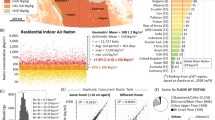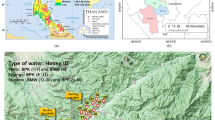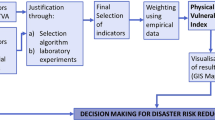Abstract
Radon is a carcinogenic radioactive gas produced by the decay of uranium. Accumulation of radon in residential structures contributes to lung cancer mortality. The goal of this research is to predict residential radon vulnerability classes for the province of British Columbia (BC) at aggregated spatial units. Spatially referenced indoor radon concentration data were partitioned into low, medium, and high classes of radon vulnerability. Radon vulnerability classes were then linked to environmental and housing data derived from existing geospatial datasets. A Balanced Random Forests algorithm was used to model environmental predictors of indoor radon vulnerability and values at un-sampled locations across BC. A model was generated and evaluated using accuracy, precision, and kappa statistics. The influence of predictor variables was investigated through variable importance and partial dependence plots. The model performed 34% better than a random classifier. Increased probabilities of high vulnerability were associated with cold and dry winters, close proximity to major river systems, and fluvioglacial and colluvial soil parent materials. The Kootenays and Columbia-Shuswap regions were most at risk. Here, we present a novel method for predictive radon mapping that is broadly applicable to regions throughout the world.
This is a preview of subscription content, access via your institution
Access options
Subscribe to this journal
Receive 6 print issues and online access
$259.00 per year
only $43.17 per issue
Buy this article
- Purchase on Springer Link
- Instant access to full article PDF
Prices may be subject to local taxes which are calculated during checkout






Similar content being viewed by others
References
World Health Organization WHO Handbook on Indoor Radon: A Public Health Perspective. Geneva. 2009 doi:10.1080/00207230903556771.
Saccomanno G, Huth GC, Auerbach O, Kuschner M . Relationship of radioactive radon daughters and cigarette smoking in the genesis of lung cancer in uranium miners. Cancer 1988; 62: 1402–1408.
Chen J, Moir D, Whyte J . Canadian population risk of radon induced lung cancer: a re-assessment based on the recent cross-Canada radon survey. Radiat Prot Dosimetry 2012; 152: 9–13.
Bissett RJ, McLaughlin JR . Radon. Chronic Dis Can 2010; 29 (Supple): 38–50.
Charles M . UNSCEAR Report 2000: Sources and Effects of Ionizing Radiation. J Radiol Prot 2001; 21: 83.
Michel J . Sources. In: Cothern CR, Smith JE (eds) Environmental Radon. Plenum Press: New York. 1987 pp 81–130.
Nazaroff WW . Radon transport from soil to air. Rev Geophys 1992; 30: 137–160.
Arnold BW . Radon transport. In: Ho CK, Webb SW (eds) Gas Transport in Porous Media. Springer: Netherlands. 2006 pp 333–338.
Washington JW, Rose AW . Regional and temporal relations of radon in soil gas to soil temperature and moisture. Geophys Res Lett 1990; 17: 829–832.
Schumann RR, Owen DE, Asher-Bolinder S . Weather factors affecting soil-gas radon concentrations at a single site in the semiarid Western U.S. Proceedings of the 1988 International Radon Symposium 1988. AARST: The American Association of Radon Scientists and Technologists: Denver, CO.
Appleton JD . Radon: sources, health risks, and hazard mapping. Ambio 2007; 36: 85–89.
Vasilyev AV, Zhukovsky MV . Determination of mechanisms and parameters which affect radon entry into a room. J Environ Radioact 2013; 124: 185–190.
Al-Ahmady KK, Hintenlang DE . Assessment of temperature-driven pressure differences with regard to radon entry and indoor radon concentration. Proceedings of the 1994 International Radon Symposium 1994. AARST: The American Association of Radon Scientists and Technologists: Atlantic city, NJ, III6.1–III6.11.
Kitto ME . Interrelationship of indoor radon concentrations, soil-gas flux, and meteorological parameters. J Radioanal Nucl Chem 2005; 264: 381–385.
Wang F, Ward IC . Radon entry, migration and reduction in houses with cellars. Build Environ 2002; 37: 1153–1165.
Garbesi K, Sextro R, Fisk WJ, Modera MP, Revzan KL . Soil-gas entry into an experimental basement : model measurement comparisons and seasonal effects. Environ Sci Technol 1993; 27: 466–473.
Varley NR, Flowers AG . Indoor radon prediction from soil gas measurements. Health Phys 1998; 74: 714–718.
Appleton JD, Miles JCH . A statistical evaluation of the geogenic controls on indoor radon concentrations and radon risk. J Environ Radioact 2010; 101: 799–803.
Jones LD, Uranium and Thorium Occurences in British Columbia 1990. http://www.empr.gov.bc.ca/Mining/Geoscience/PublicationsCatalogue/OpenFiles/1990/Documents/OF1990-32.pdf.
Drolet J-P, Martel R, Poulin P, Dessau J-C, Lavoie D, Parent M et al. An approach to define potential radon emission level maps using indoor radon concentration measurements and radiogeochemical data positive proportion relationships. J Environ Radioact 2013; 124: 57–67.
Drolet J-P, Martel R, Poulin P, Dessau J-C . Methodology developed to make the Quebec indoor radon potential map. Sci Total Environ 2014; 473-474: 372–380.
O’Reilly GA, Goodwin TA, McKinnon JS, Fisher BE, Map showing the potential for radon in indoor air in Nova Scotia. Nov. Scotia Dep. Nat. Resour. Miner. Resour. Branch, Open File Map ME 2013-028 2013. http://novascotia.ca/natr/meb/data/mg/ofm/pdf/ofm_2013-028_d486_dp.pdf.
Radon Environmental Management Corp. Radon Potential Map of Canada 2011. http://www.radoncorp.com/pdf/presentationMappingPublic.pdf. accessed 14 Nov2013.
Appleton JD, Ball T . Geological radon potential mapping. In: Bobrowsky PT (ed) Geoenvironmental Mapping: Methods, Theory and Practice. A.A. Balkema Publishers: Exton, PA. 2002 pp 577–613.
Ielsch G, Cushing ME, Combes P, Cuney M . Mapping of the geogenic radon potential in France to improve radon risk management: methodology and first application to region Bourgogne. J Environ Radioact 2010; 101: 813–820.
Gruber V, Bossew P, De Cort M, Tollefsen T . The European map of the geogenic radon potential. J Radiol Prot 2013; 33: 51–60.
Rauch SA, Henderson SB . A comparison of two methods for ecologic classification of radon exposure in British Columbia: residential observations and the radon potential map of Canada. Can J Public Heal 2013; 104: e240–e245.
Miles JCH, Appleton JD . Mapping variation in radon potential both between and within geological units. J Radiol Prot 2005; 25: 257–276.
Canada H. Government of Canada Radon Guideline 2012. http://www.hc-sc.gc.ca/ewh-semt/radiation/radon/guidelines_lignes_directrice-eng.php. accessed 7 Jan2014.
Breiman L . Random forests. Mach Learn 2001; 45: 5–32.
Cutler DR, Edwards TC, Beard KH, Cutler A, Hess KT, Gibson J et al. Random forests for classification in ecology. Ecology 2007; 88: 2783–2792.
Prasad AM, Iverson LR, Liaw A . Newer Classification and Regression Tree Techniques: Bagging and Random Forests for Ecological Prediction. Ecosystems 2006; 9: 181–199.
Breiman L, Friedman JH, Olshen RA, Stone CJ . Classification and Regression Trees. Wadsworth International Group: Belmont, California. 1984.
Chen C, Liaw A, Breiman L . Using random forest to learn imbalanced data. University of California, Berkeley, 2004. http://statistics.berkeley.edu/sites/default/files/tech-reports/666.pdf (accessed 7 Aug2014).
Liaw A, Wiener M . Classification and Regression by randomForest. R News 2002; 2: 18–22.
Fatourechi M, Ward RK, Mason SG, Huggins J, Schlögl A, Birch GE . Comparison of evaluation metrics in classification applications with imbalanced datasets. Machine Learning and Applications, 2008. ICMLA ’08. Seventh International Conference on 2008. IEEE: San Diego, 777–782.
Cohen J . A Coefficient of Agreement for Nominal Scales. Educ Psychol Meas 1960; 20: 37–46.
Archer KJ, Kimes RV . Empirical characterization of random forest variable importance measures. Comput Stat Data Anal 2008; 52: 2249–2260.
Berk RA . Statistical Learning from a Regression Perspective. Springer New York: New York, NY. 2008 doi:10.1007/978-0-387-77501-2.
Strobl C, Boulesteix A-L, Zeileis A, Hothorn T . Bias in random forest variable importance measures: illustrations, sources and a solution. BMC Bioinformatics 2007; 8: 25.
De’ath G . Boosted trees for ecological modeling and prediction. Ecology 2007; 88: 243–251.
Statistics Canada. Census Dictionary 2011. Stat. Canada Cat. no. 98-301-X2011001 2011. http://www12.statcan.gc.ca/census-recensement/2011/ref/dict/98-301-X2011001-eng.pdf. accessed 29 Aug2014.
Kropat G, Bochud F, Jaboyedoff M, Laedermann J-P, Murith C, Palacios M et al. Major influencing factors of indoor radon concentrations in Switzerland. J Environ Radioact 2014; 129: 7–22.
Mose D, Mushrush G, Chrosniak C . Seasonal Indoor Radon Variations Related to Precipitation. Environ Mol Mutagen 1991; 17: 223–230.
Schaetzl RJ, Anderson S . Soils : genesis and geomorphology. Cambridge University Press: New York. 2005.
Nazaroff WW, Nero AV . Transport of radon from soil into residences. Proceedings of the Third International Conference on Indoor Air Quality and Climate 1984, Swedish Council for Building Research; 2: 15–21.
Lett RE, Nakanishi T, Desjardins PJ, Man E, Mihalynuk MG, GeoFile 2008-1: A Drainage Geochemical Atlas for British Columbia 2008.
Heung B, Bulmer CE, Schmidt MG . Predictive soil parent material mapping at a regional-scale: A Random Forest approach. Geoderma 2014; 214-215: 141–154.
Gundersen LCS, Schumann RR . Mapping the radon potential of the United States: Examples from the Appalachians. Environ Int 1996; 22 (Supple): 829–837.
Hauri DD, Huss A, Zimmermann F, Kuehni CE, Röösli M . A prediction model for assessing residential radon concentration in Switzerland. J Environ Radioact 2012; 112: 83–89.
Hystad P, Brauer M, Demers Pa, Johnson KC, Setton E, Cervantes-Larios A et al. Geographic variation in radon and associated lung cancer risk in Canada. Can J Public Health 2014; 105: e4–e10.
Henderson SB, Rauch Sa, Hystad P, Kosatsky T . Differences in lung cancer mortality trends from 1986-2012 by radon risk areas in British Columbia, Canada. Health Phys 2014; 106: 608–613.
Statistics Canada. Table153-0098 - Households and the environment survey, knowledge of radon and testing, Canada and provinces, every 2 years (percent). CANSIM 2012. http://www5.statcan.gc.ca/cansim/pick-choisir?lang=eng&p2=33&id=1530098. accessed 7 Nov2013.
Malmqvist L, Isaksson M, Kristiansson K . Radon migration through soil and bedrock. Geoexploration 1989; 26: 135–144.
Scheib C, Appleton JD, Miles JCH, Hodgkinson E . Geological controls on radon potential in England. Proc Geol Assoc 2013; 124: 910–928.
Cui Y, Katay F, Nelson J, Han T, Desjardins PJ, Sinclair L, British Columbia Digital Geology: BCGS Open File 2013-04. BC Geol. Surv 2013. http://www.empr.gov.bc.ca/MINING/GEOSCIENCE/PUBLICATIONSCATALOGUE/OPENFILES/2013/Pages/2013-4.aspx. accessed 15 Apr 2014.
Ioannides K, Papachristodoulou C, Stamoulis K, Karamanis D, Pavlides S, Chatzipetros A et al. Soil gas radon: a tool for exploring active fault zones. Appl Radiat Isot 2003; 59: 205–213.
Agriculture and Agri-Food Canada. Soil Landscapes of Canada (SLC). Gov. Canada 2013. http://sis.agr.gc.ca/cansis/nsdb/slc/index.html. accessed 15 May 2014.
Shweikani R, Giaddui TG, Durrani Sa . The effect of soil parameters on the radon concentration values in the environment. Radiat Meas 1995; 25: 581–584.
Wang T, Hamann A, Spittlehouse DL, Murdock TQ . ClimateWNA—high-resolution spatial climate data for western North America. J Appl Meteorol Climatol 2012; 51: 16–29.
Cosma C, Cucoş A, Papp B, Begy R, Dicu T, Moldovan M et al. Radon and remediation measures near Băiţa-Ştei old uranium mine (Romania). Acta Geophys 2013; 61: 859–875.
GeoBC. Freshwater Atlas 2014. http://geobc.gov.bc.ca/base-mapping/atlas/fwa/. accessed 15 Apr2014.
Gunby JA, Darby SC, Miles JC, Green BM, Cox DR . Factors affecting indoor radon concentrations in the United Kingdom. Health Phys 1993; 64: 2–12.
Verger P, Hubert P, Cheron S, Bonnefous S, Bottard S, Brenot J . Use of field measurements in radon mapping in France. Radiat Prot Dosimetry 1994; 56: 225–229.
Gerken M, Kreienbrock L, Wellmann J, Kreuzer M, Wichmann HE . Models for retrospective quantification of indoor radon exposure in case-control studies. Health Phys 2000; 78: 268–278.
Statistics Canada. National Household Survey (NHS) Profile, 2011. [2013]. Stat. Canada 2013. http://hdl.handle.net/10573/42928. accessed 7 Jan2014.
Lesack P, Combined Dissemination Block Digital Cartographic File and Geographic Attribute File, 2011 [2012] [Census of Canada, 2011]. Census Canada. 2011. 2012 http://hdl.handle.net/10573/42747. accessed 7 Jan2014.
Acknowledgements
We would like to thank Paul Schiarizza of BC Ministry of Energy and Mines for consultation on geological categorization and Dr. Chuck Bulmer of the BC Ministry of Forests and Range for consultation on available soil datasets. We would also like to thank the BC Lung Association, Northern Health Authority, Donna Schmidt Foundation and Peter Chataway for sharing their data. This work has been supported by the Social Sciences and Humanities Research Council of Canada and the Natural Sciences and Engineering Research Council of Canada.
Author information
Authors and Affiliations
Corresponding author
Ethics declarations
Competing interests
The authors declare no conflict of interest.
Rights and permissions
About this article
Cite this article
Branion-Calles, M., Nelson, T. & Henderson, S. A geospatial approach to the prediction of indoor radon vulnerability in British Columbia, Canada. J Expo Sci Environ Epidemiol 26, 554–565 (2016). https://doi.org/10.1038/jes.2015.20
Received:
Revised:
Accepted:
Published:
Issue Date:
DOI: https://doi.org/10.1038/jes.2015.20
Keywords
This article is cited by
-
Prediction of Prednisolone Dose Correction Using Machine Learning
Journal of Healthcare Informatics Research (2023)



